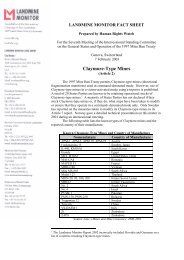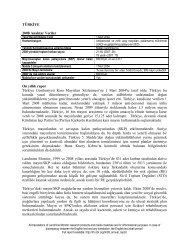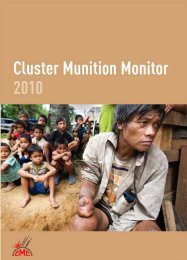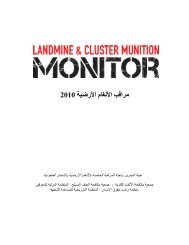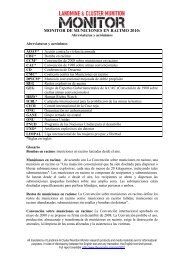Download PDF - Landmine and Cluster Munition Monitor
Download PDF - Landmine and Cluster Munition Monitor
Download PDF - Landmine and Cluster Munition Monitor
Create successful ePaper yourself
Turn your PDF publications into a flip-book with our unique Google optimized e-Paper software.
© Mary Wareham/HRW, September 2011<br />
Casualties <strong>and</strong> Victim Assistance<br />
The rationale behind the Convention on <strong>Cluster</strong> <strong>Munition</strong>s is found in its preamble, which affirms that States Parties<br />
are “[d]etermined to put an end for all time to the suffering <strong>and</strong> casualties caused by cluster munitions.” This l<strong>and</strong>mark<br />
humanitarian disarmament agreement is the first <strong>and</strong> so far the only international treaty to make the provision of assistance<br />
to victims of the weapons a formal requirement for all States Parties.<br />
Documentation of casualties from cluster munition strikes as well as from cluster munition remnants remains<br />
inadequate. 1 There are no comprehensive, reliable statistics <strong>and</strong> both civilian <strong>and</strong> military casualties are underreported.<br />
The <strong>Monitor</strong> has managed to identify a total of 17,194 cluster munition casualties in 30 countries through the end of 2011,<br />
yet a better indicator of the number of cluster munition casualties globally is the estimated total of between 20,000 <strong>and</strong><br />
54,000 casualties. However, the number of casualties that occurred during cluster munition strikes is known to be grossly<br />
underrepresented in both recorded casualties <strong>and</strong> estimates.<br />
Afghanistan, Iraq, Lao PDR, Lebanon, Cambodia, <strong>and</strong> Vietnam are considered to be the “worst affected” countries with<br />
significant numbers of cluster munition victims. 2 While all states are encouraged to provide victim assistance resources<br />
<strong>and</strong> support, the convention places ultimate responsibility for the provision of victim assistance on the countries with<br />
cluster munition victims because it is their duty to protect <strong>and</strong> care for their own people.<br />
Under Article 5 of the convention, States Parties have a legal obligation to ensure that the rights are met for members<br />
of their population whose lives have been impacted by cluster munitions. In order to make a difference in affected<br />
communities, there must be a clear underst<strong>and</strong>ing of the needs of victims <strong>and</strong> victim assistance responses must be<br />
coordinated, focused, <strong>and</strong> measurable.<br />
In the two years since the convention entered into force on 1 August 2010, States Parties have reported making more<br />
efforts than ever before to improve the lives of cluster munition victims, demonstrating that the convention is making a<br />
difference particularly in those countries most affected. While there has been progress on victim assistance during the<br />
reporting period, it remains generally uneven due to lack of funding to the NGOs which deliver most services, <strong>and</strong> due to<br />
inadequate infrastructure, conflict, <strong>and</strong> other challenges.<br />
<strong>Cluster</strong> <strong>Munition</strong> Casualties<br />
Global casualties<br />
Casualties from cluster munition remnants have been recorded by at least 30 states <strong>and</strong> three other areas where cluster<br />
munitions have been used, as listed in the following table. There have been unconfirmed casualties in several more states. 3<br />
A football<br />
match<br />
between<br />
cluster bomb<br />
survivors,<br />
campaigners<br />
<strong>and</strong> diplomats<br />
during the<br />
Second<br />
Meeting<br />
of States<br />
Parties to the<br />
Convention<br />
on <strong>Cluster</strong><br />
<strong>Munition</strong>s<br />
in Beirut,<br />
Lebanon.<br />
1<br />
The term “cluster munition remnants” includes explosive bomblets <strong>and</strong> unexploded submunitions, which account for the vast majority of<br />
casualties. Unexploded submunitions are submunitions that have been dispersed <strong>and</strong> have l<strong>and</strong>ed, but failed to explode as intended, while<br />
“explosive bomblets” have been dropped from a fixed-wing aircraft dispenser, but have failed to explode as intended.<br />
2<br />
“Draft Beirut Progress Report,” CCM/MSP/2011/WP.5, 25 August 2011, pp. 10-11. http://www.clusterconvention.org/files/2011/05/Beirut-<br />
Progress-Report-ODS-upload4.pdf.<br />
3<br />
<strong>Cluster</strong> munition casualties have been reported in Angola, Chad, Guinea-Bissau, Libya, Mozambique, <strong>and</strong> Yemen, but no definite data on<br />
numbers of casualties is currently available. It is possible that cluster munition casualties have gone unrecorded in other countries where<br />
cluster munitions were used, ab<strong>and</strong>oned, or stored in the past, such as Azerbaijan, Colombia, Iran, Mauritania, Saudi Arabia, <strong>and</strong> Zambia, as<br />
well as the Falkl<strong>and</strong> Isl<strong>and</strong>s/Malvinas.<br />
51



